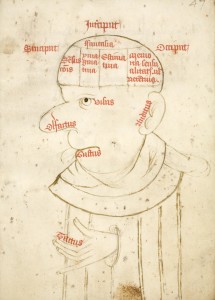Life from Within: Physiology and Talismanic Efficacy in Marsilio Ficino’s De vita (1498)
by Tanja Klemm
The essay begins:
Marsilio Ficino’s De vita, published in 1489 in Florence, is exclusively dedicated to the physical well-being of the sensible living organism—or the corpus animatum, as it had been called since late medieval times. In the proem to the work, Ficino makes it clear that in De vita he writes not as a philosopher, theologian, or priest but as a doctor, a scholar of medicine—of medicina theorica and of medicina practica. And indeed, with its focus on the regimen of intellectuals, of litterati, all three books of the treatise are deeply rooted in contemporary medical knowledge. In this sense, in De vita everything revolves around human physiology, which in that period was understood as the doctrine of nature (physis) dedicated to the understanding of natural processes in living organisms and the constitution of life. In the third book, entitled De vita coelitus comparanda (On Obtaining Life from the Heavens) this physiology is amplified into a cosmological doctrine of life and living matter: throughout the text it is connected to astrology—to the macrocosm and to the living stars and planets. To modern eyes, Ficino in De vita coelitus comparanda leaves the realm of physiology and, contrary to his statement in the proem, enters philosophy—or better, natural philosophy. But in premodern times philosophy was part of the medical curriculum, and thus medicine and astrology were tightly linked.

Pseudo-Augustine, Libellus de anima et spiritu, early thirteenth century. Trinity College, Cambridge, MS 0.7.16, 47r. © The Master and Fellows of Trinity College, Cambridge.
In the following pages, I would like to focus on the fact that within this cosmological physiology De vita coelitus comparanda develops a consistent phenomenology of imagines efficaces (efficient images). One could also call these imagines “medical talismans,” because, according to Ficino, they act on the spirit, body, and soul of a person—as does medicine, prescribed in the right way. Further, they can absorb powers from the heavens— as can medicine. Thus, in De vita coelitus comparanda, both imagines and medicine are embedded in an astrological framework—and this makes them both talismanic.
Ficino however does not use the term “talisman” in his treatise. Instead, he speaks throughout of imagines (sometimes effigies) or figurae. Imagines, per Ficino, refer to artifacts “made out of metals or stones by astrologers,” that is, to three-dimensional artifacts produced by specialists. He also goes on to specify their production, this time with assistance by “ancients” like Ptolemy, Haly Abbas, Platonist thinkers, and the Egyptians. In order to be useful (utilis), he explains, imagines can be formed according to the planetary constellation or the “celestial aspect” (vultus coelestis) whose healing power one wishes to attract. Figurae, on the other hand, do not designate three-dimensional artifacts in Ficino’s terminology. They refer instead to the figures and signs incised in imagines.
And De vita coelitus comparanda goes even further: it tells us how the forces of imagines—with or without figurae—are connected to both the human organism and the realm of the heavens. Within this framework, it provides a model of perception based on embodiment, immanent embeddedness, and participation rather than on visuality and observation. It focuses on how imagines or medical talismans worked and how the efficacy of these artifacts was conceived, perceived, and experienced. It explains the belief that talismanic powers had to be mingled with the forces—the spiritūs and virtutes—of the human organism in order to be felt or to lead to any kind of psychophysical metamorphosis, be it the cure of disharmonies of the corporeal humors or the refinement of the corporeal spiritus required to perform intellectual work or to enhance the proper generative (that is, procreative) forces. In short, De vita coelitus comparanda gives us an idea about how efficient images were perceived in the Renaissance. It is this consistent historical phenomenology of efficacy that makes Ficino’s text so original. Continue reading …
In his medical treatise De vita (1498), Marsilio Ficino describes the force of medical talismans and their efficacy on humans against the background of a cosmological physiology. This article focuses on the question of how—according to Ficino—the powers of medical talismans were experienced by humans, by the living, sensible body (corpus animatum). Discussion of this question also leads to theoretical considerations about the efficacy of artifacts in the Renaissance.
TANJA KLEMM is an art historian currently working as research assistant at the Morphomata Center for Advanced Studies in the Humanities at the University of Cologne. She is the author of Bildphysiologie. Körper und Wahrnehmung in Mittelalter und Renaissance (2013) and co-editor of Sind alle Denker traurig? Fallstudien zum melancholischen Grund des Schöpferischen in Asien und Europa (2015). Currently she is preparing, with Stephanie Dieckvoss, a monographic issue for Kunstforum International on the formation of artists in a global perspective.
